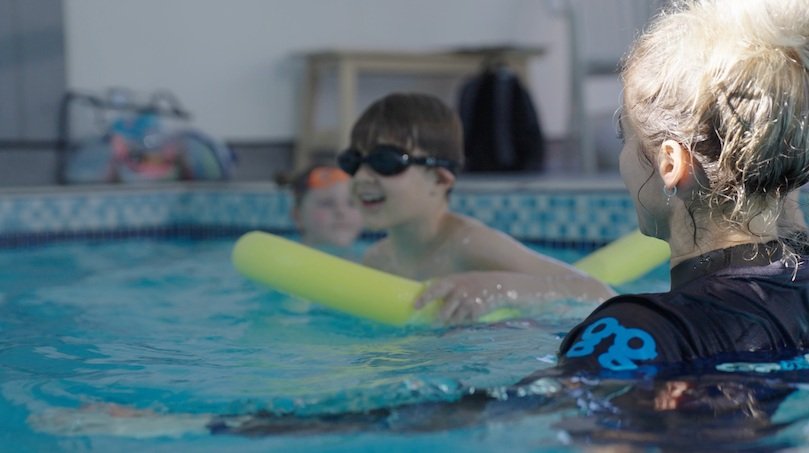
The GoggleSquad Swim Teaching Programme
We use a combination of the Swim England Framework and other proven swim teaching methods to offer the very best swim teaching programme for learners.
Baby and Toddler swimming lessons (0-3 years old)
When working with very young children, understanding child development - physical and emotional - is key to delivering engaging, effective and progressive lessons.
We are members of the Swimming Teachers Association (STA), Aqua Sensory and Aqua Education bodies and learn from them all to offer an extensive and well-rounded programme of early years lessons.
We are proud to be a Swim England Swim School and use the Swim England Pre-school Framework to keep track of babies’ and toddlers’ progress.
The early months up to age of one are important for helping children get a ‘feel’ for how their bodies move in the water.
The swimming pool can be a daunting place for a small child, so they must feel in control at all times and having a parent or carer in the pool with them up to the age of three is essential.
For instructors, being able to read a child's body language (non-verbal communication) is imperative, and teaching parents to read the signs is also vitally important. This leads to children who are happy and confident in the water and ultimately, better learning outcomes.
It’s all about the play!
Not surprisingly, play is the essential foundational component to all early years lessons, encompassing schematic, imaginative, exploratory and constructive play.
All children’s lessons include sensory-based activities which are rocket fuel for children’s brains. Sensory play develops physical literacy and supports mental and emotional wellbeing in and out of the water.
To keep lessons interesting we often take inspiration from children’s books like The Gruffalo or TV programmes such as Paw Patrol or Octonauts and also draw on general themes like ‘space’, ‘shopping’ or ‘pirates’.
Buoyancy aids are only used when working or focusing on a specific desired outcome, such as balance, strength, body position, breath control, movement and so on.
The most important things to familiarise learners with as soon as possible are the ability to float independently - on their backs and their front - and aquatic breathing (comfortably blowing bubbles with their faces in the water). A child needs to be able to do both of these before progressing to learning swimming strokes.
If we could sum up our ethos for early years learning in one word, it would be ‘fun’. Fun is the key ingredient for effective learning…and delivers the best results at all ages.
Pre-school swimming lessons (3-4 years old)
Our swimming lessons for pre-school children aged from around three years old are focussed on developing the key water skills that underpin all swimming strokes.
When they get to this age, most children are stronger and able to take more specific instructions; that’s when their learning can really accelerate. They can be ready to move on from being comfortable in the water to focussing more on specific activities and skills such as balance, buoyancy, rotation, aquatic breathing and propulsion with their arms and legs - the building blocks for learning to swim.
At GoggleSquad we follow the ‘BLABT’ principles, a rather ugly acronym for the different stages of learning each swimming stroke: Body position, Legs, Arms, Breathing and Timing, all of which we teach through play and various engaging activities.
School-age swimming lessons (4 years and above)
Once they’re at school-age, learners generally move on to the GoggleSquad Academy to continue their swimming journey. If we could sum up our priority for this age group in one word, it would be ‘technique’.
Technique is the single most important element of swimming - if you can get a child's technique right, the rest will follow.
Success for these learners depends on the fundamentals being in place. Teaching the fundamentals requires deep knowledge and a clear understanding of body mechanics - and how those elements come together to achieve the desired result.
We follow the excellent Swim England Learn To Swim Framework to deliver lessons for school-aged children. Our teaching is also influenced and inspired by other experts and their teaching methods, including teacher social networks, books written by industry professionals such as Ray Lau, FINA (who govern competitive swimming), and GoSwim TV, a members-only video tutorial platform. We also watch and read articles from authorities on teaching including SwimSwam, Coach Bowman, British Swimming, Fitter and Faster, Michael Phelps and Adam Walker.
Fun and games also feature in lessons for this age group, but they must have a purpose and lead to the desired outcome of the lesson. For example, if the lesson objective is to improve front crawl pull, we may set swimmers the challenge of achieving a target number of arm pulls over a 100m distance.
Even with competent swimmers whose technique needs improving, we will often go back to the beginning to ensure the fundamentals are in place before putting their stroke back together.
We believe in teaching children to swim well and fostering the satisfaction gained from reaching their full potential in the water. Even if a child has no intention or desire to swim competitively, we teach them as if they have.
We sometimes use 360 degree video analysis to show a child how they are performing a stroke or skill and this is particularly effective for those children who are visual learners. We also encourage children (and adults) to Google a stroke or specific skill they will be working on the following week so they have a visual representation of what the stroke or skill looks like when performed well.
For this age group we have an in and out of the water approach to instructing which offers a full 360 degree view of progress. To deliver the best quality lessons, the instructor needs to be in the water to observe and correct a child ‘in the moment’ and also benefit from the bird’s eye view offered by the poolside vantage point.




